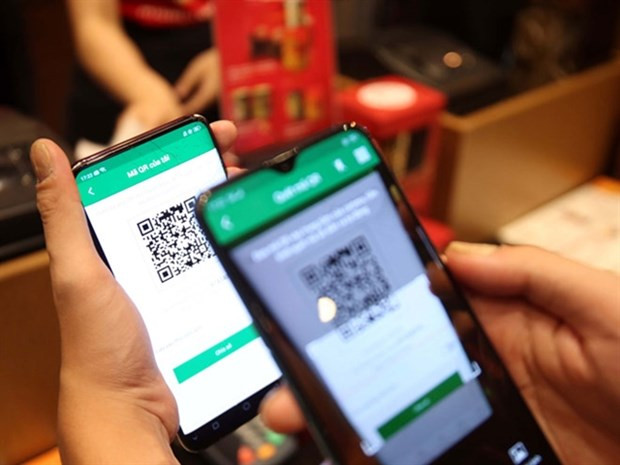 The popularity of contactless payments rockets in Vietnam, with banks launching more options for customers to enjoy going cashless. (Photo: vtv.vn)
The popularity of contactless payments rockets in Vietnam, with banks launching more options for customers to enjoy going cashless. (Photo: vtv.vn)Hanoi (VNA) - The popularity of contactlesspayments has rocketed in Vietnam over the last few years, with banks launchingmore options for customers to enjoy going cashless.
Contactless payments are a new technology that allowusers to simply tap their card, smartphone, or wearable device against a POSterminal to pay, rather than swipe or insert a card.
They are gaining in favour among shoppers in Vietnambecause they are a faster, more secure, and more convenient way to pay. TheCOVID-19 pandemic also appears to have further encouraged people to adoptcontactless payments due to increasing concerns about hygiene and socialdistancing measures.
Data from the State Bank of Vietnam (SBV) shows thatthe number of domestic banking transactions grew 26.2 percent in the first fourmonths of this year, with value rising 15.7 percent. Mobile payments increasedsharply by 189 percent in number and 166 percent in value from a year earlier.
The latest Visa Consumer Payment Attitudes study foundthat 37 percent of respondents were using contactless payment cards, 42 percentof them made mobile contactless payments.
Of those already using contactless payment methods, 85percent are doing so at least once a week, the study found.
It also revealed that four out of five consumers whohave not used contactless payments are interested in doing so. More than 80percent expressed an interest in biometric authentication technology, whichuses fingerprints or facial or voice recognition to authenticate payments.
More domestic banks have converted their cards intocontactless smart cards, such as Techcombank, BIDV, Vietcombank, Kienlongbankand TPBank, among others.
“Cashless transactions benefit both businesses andcustomers, and these benefits go both ways,” said Dang Tuyet Dung, Visa CountryManager for Vietnam and Laos. “When customers have a better experience,merchants will benefit from increased transactions and shopper loyalty, andwhen merchants are operating more efficiently and effectively, they can betterserve customers.”
“It really is a win-win proposition,” she noted.
TPBank, Vietinbank, and Sacombank allow cashwithdrawals using a QR Code at their ATMs, while customers can scan theirfingerprints to receive cash at either the ATMs or transaction offices ofEximbank and VietBank without a debit card, an ID card, or a passport.
These technologies make money transfers, cashwithdrawals, and payments easier and more secure as they reduce the possibilityof card loss, card theft, or data theft, according to Dr Nguyen Tri Hieu, abanking and financial specialist.
When fintech firms began to appear a few years ago,banks viewed them as competitors, Chief Information Officer (CIO) at VietCapitalBankPhan Viet Hai said. Now, they view them as partners to together provide moreconvenient services for customers.
VietCapitalBank has worked with popular e-wallets suchas ZaloPay and AirPay to enable its card holders to make cashless payments atconvenience stores like 7-Eleven, Circle K, and others.
Hai also noted that the greatest challenges to thesustainable development of e-wallets and Mobile Money remain in identityverification and security.
Banks must abide by SBV and international rulesregarding identity verification to prevent money laundering and protect users’assets, he said, emphasising the need for a legal framework on identityverification and transaction safety and security./.





























